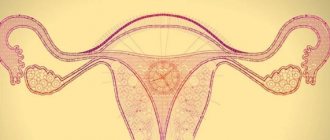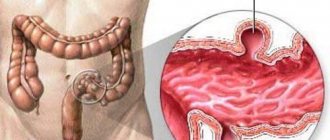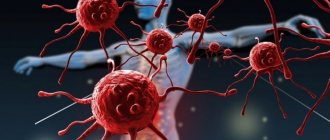Tumor markers are specific substances found in the blood and urine, which can be both waste products of the tumor and substances synthesized by healthy cells in response to the invasion of cancer cells. Detection of tumor markers in the body makes it possible to diagnose the oncological process at an early stage and monitor the dynamics of pathology during treatment.
Who needs to be tested for tumor markers?
People whose relatives have been diagnosed with tumors of various locations should take tests for tumor biomarkers as screening tests 1–2 times a year.
People who have benign tumors (adenoma, myoma, fibroma) or tumor-like formations (kidney cysts, ovarian cysts) need to be examined with the same frequency. The rest can be tested for tumor markers once every 2-3 years.
People who have undergone cancer therapy should be tested for tumor biomarkers: every month during the first year, once every 2 months during the second year, once every 3 months during the third to fifth year. Five years after cancer treatment, it is sufficient to undergo tumor marker testing once every 6–12 months.
Tumor biomarkers can be detected in urine, blood, prostatic juice, fluid taken from the pleura or abdominal cavity. Specific antibodies are added to a sample of biological fluid taken from the patient. They form specific complexes with the protein structure of the tumor marker, which are identified by laboratory methods. Non-protein tumor biomarkers are determined by other methods.
Indications for diagnosis using tumor markers
Blood samples are taken on an empty stomach.
Tests are taken in any laboratory. The biological material will be the presence of markers that are released in the small or large intestine. There are some conditions that must be met before starting the test:
- blood must be donated on an empty stomach;
- after this, blood is donated eight hours later after eating;
- Before taking this test, you should not eat fatty or spicy foods or drink alcohol;
- the patient should also not smoke;
- blood is drawn after the patient has rested for 15 minutes.
To be able to detect Tu M2-RK, it is necessary to undergo a stool test. It happens when you go to the toilet naturally. You cannot take laxatives, and you must not use an enema. Two teaspoons of feces are placed in a special container, after which it is sent to the laboratory.
The results will be available after seven days.
Most frequently identified tumor markers
75% of cancer patients have elevated alpha-fetoprotein (AFP) levels. Most often it is elevated in liver cancer; also, its high level can indicate testicular and ovarian cancer (in 5% of cases).
The tumor marker beta-2-microglobulin indicates the development of lymphoma and multiple myeloma. Markers CA 27-29, CA 15-3 indicate possible breast cancer, CA 125 - ovarian cancer. Biomarkers LASA-P, CA 72-4 make one suspect the presence of ovarian cancer and gastrointestinal tumors. The CA 19-9 marker is detected in cancer of the pancreas.
Tumor markers (tumor markers) – what are they?
03/21/2018 Tumor markers (tumor markers) are substances of various natures that, when present in liquid media (urine, blood, etc.) of the human body in certain concentrations, indicate the presence of a tumor in it. The value of tumor markers for diagnosis depends on their specificity and sensitivity. Specificity is the percentage of negative tumor marker results in tests in healthy individuals. Sensitivity is the percentage of positive tumor markers in tests in cancer patients. However, to date, there is not a single marker of tumor growth that is 100% found only in patients with cancer. Tumor markers can also increase in inflammatory diseases of various origins, benign processes in the body, etc. Tumor marker CA 125 - early diagnosis of ovarian cancer. Tumor marker CA 125 is a protein that is synthesized by the mesothelium of the serous membranes: pleura, pericardium, peritoneum. In women, this protein is secreted by the endometrium of the uterus, so its concentration in the blood changes during the menstrual cycle. The upper limit of normal CA 125 for 94% of healthy individuals is a level of less than 35 U/ml. In menopausal women, the discriminatory level is less than 20 U/ml. CA 125 levels in patients with ovarian cancer after treatment should be less than 10 U/ml. The CA 125 tumor marker is mainly used for the early diagnosis of ovarian cancer in women of menopausal age and in women with a family history of ovarian cancer. And for young women it has low specificity and sensitivity. They may have other reasons for the increase in this tumor marker:
1. Cancers (uterine endometrial cancer, breast cancer, pancreatic cancer, lung cancer, colorectal cancer, stomach cancer, primary liver cancer, liver metastases. 2. Other diseases. ● Diseases involving the serous membranes (pleurisy, peritonitis , pericarditis). ● Pelvic inflammatory diseases, pneumonia, hepatitis, pancreatitis, cirrhosis, renal failure. In this case, the tumor marker CA 125, like many other tumor markers, acts as an inflammatory protein. ● Ovarian cysts and benign tumors. ● Endometriosis of various localizations. 3. Pregnancy, menstruation. The tumor marker CA 125 is also used to determine the relapse of ovarian cancer: a persistent increase in its level in patients in remission means a relapse of the disease. CA 125 is also used to assess the effectiveness of treatment for ovarian cancer. In the clinical diagnostic laboratory You can undergo testing for the tumor marker CA 125 at the Central Regional Hospital of the Volgodonsk region.
Tumor marker CEA (carcinoembryonic antigen) Tumor marker CEA refers to the antigens of the fetus, in which it is produced in the mucous membranes of the intestines and stomach. After birth, its synthesis decreases. The discriminatory level of CEA is less than 3–5 ng/ml; in smokers a level of less than 10 ng/ml is possible. The CEA tumor marker is primarily a marker for colon and rectal cancer. It reflects the volume of the cancer tumor before surgery, as well as the prognosis and five-year survival of patients after treatment. CEA also increases in adenogenic tumors (tumors from glandular tissue): stomach cancer, lung adenocarcinoma, breast cancer, pancreatic cancer, ovarian cancer, prostate cancer, endometrial cancer. And other diseases of the liver, lungs, and gastrointestinal tract. The tumor markers CEA, CA 19-9 and CA 72-4 together have high sensitivity for gastrointestinal tumors. CEA is a sensitive marker of metastases of adenogenic tumors in the bones, lungs, and liver.
The CEA tumor marker is also used to assess the effectiveness of treatment for patients with adenogenic tumors. Tumor marker SCC (antigen for squamous cell carcinoma) Tumor marker SCC - a marker for squamous cell carcinoma, is a protein that is synthesized by epithelial cells of the skin, bronchi, cervix, esophagus, and anal canal. The upper limit of normal (discriminatory level) is 1.5 ng/ml. The SCC tumor marker increases in the presence of squamous epithelial tumors: cervical cancer, tongue cancer, head and neck cancer, esophageal cancer, lung cancer, laryngeal cancer, vaginal cancer, vulvar cancer and other diseases: skin diseases (eczema, psoriasis, lichen planus ), chronic liver failure, tuberculosis, chronic renal failure. Therefore, the indications for its determination are as follows:
1. Assessing the effectiveness of therapy for patients with squamous cell carcinoma with initially elevated SCC. 2. Monitor patients with squamous cell carcinoma to diagnose relapses.
Tumor marker AFP (alpha fetoprotein) Tumor marker AFP is a fetal antigen, a transport protein of the fetal liver. The upper limit of normal is less than 15 ng/ml. The AFP tumor marker is used to diagnose hepatocellular cancer, as well as to monitor patients. AFP also increases in the presence of metastases of other tumors in the liver. In these patients, it is used to evaluate the effectiveness of treatment. Elevated AFP levels also occur in patients with ovarian tumors (chorionepitheliomas, teratomas, endodermal sinus tumors, dysgerminomas) and testicles. In these patients, AFP is used to determine relapse. The AFP tumor marker is also used to diagnose hepatocellular cancer in patients with liver cirrhosis and chronic hepatitis. Tumor marker hCG (human chorionic gonadotropin) Tumor marker hCG is a hormone synthesized by the placenta and chorion. The discriminatory level of hCG in the blood of men and non-pregnant women is less than 5 IU/ml, the borderline values are 5–10 IU/ml. The hCG tumor marker is used to diagnose pregnancy, hydatidiform mole (hCG levels reach high values, sometimes more than 1,000,000 IU/ml), choriocarcinoma (also a strong increase in hCG levels). And also for assessing the effectiveness of therapy and for the purpose of diagnosing relapses in patients with trophoblastic disease.
Tumor marker CA 19-9 Tumor marker CA 19-9 is a fetal protein synthesized by epithelial cells of the gastrointestinal tract. The discriminatory level of CA 19-9 is 37 U/ml. In adults, it is found in meager concentrations in the glandular epithelium of internal organs, so its increase means the presence in the human body of adenogenic tumors of various localizations: pancreatic cancer, stomach cancer, gall bladder cancer, ovarian cancer, colorectal cancer, esophageal cancer, liver cancer, metastatic liver cancer. Or other diseases: liver cirrhosis, hepatitis, cholelithiasis, cholecystitis, pancreatitis, cholestasis, endometriosis, cystic fibrosis, uterine fibroids. Tumor marker CA 19-9 is more often elevated in pancreatic cancer (76-81% of cases), for which it is the tumor marker of choice. For liver cancer (51-74% of cases), stomach cancer, colorectal cancer. CA 19-9 is elevated in 4179% of ovarian cancer cases. Therefore, this tumor marker is used to diagnose these diseases, assess the effectiveness of treatment and determine the progression of the disease. The CA 19-9 tumor marker is also widely used to monitor patients with endometriosis to evaluate treatment and determine disease relapse. Tumor marker CA 72-4 Tumor marker CA 72-4 is a fetal protein synthesized by the epithelium of the gastrointestinal tract (GIT). In adults, it is found in scanty concentrations in the epithelium of the gastrointestinal tract. The upper limit of normal is 5.3 U/ml. Tumor marker CA 72-4 increases more often in gastric cancer (2979% of cases) and for this it is the tumor marker of choice. It is also used in stomach cancer to diagnose relapses. For ovarian cancer, the sensitivity of CA 72-4 is 7178% and is also considered the marker of choice for this disease. The tumor growth marker CA 72-4 also increases in other cancers: pancreatic cancer, breast cancer, colon cancer, lung cancer, endometrial cancer. Tumor marker CA 15-3 Tumor marker CA 15-3 is associated with breast cancer. The upper limit of normal (discriminatory level) in non-pregnant women is 28 U/ml. In pregnant women in the 3rd trimester of pregnancy, it can increase to 50 U/ml. The sensitivity of CA 15-3 depends on the stage of breast cancer; in the early stages of the disease it has low sensitivity (about 20%), therefore it is not used for the early diagnosis of breast cancer. And with a common process, the sensitivity is 84%. Therefore, the CA 15-3 tumor marker is used to assess the effectiveness of breast cancer treatment and diagnose relapses of the disease. Tumor marker UBC (bladder cancer antigen) Tumor marker UBC is a water-soluble fragment of cytokeratins 18 and 8, synthesized by epithelial cells. As bladder cancer grows, their synthesis increases and they can be detected in urine. In urine, the concentration of the tumor marker UBC is adjusted in relation to the concentration of creatinine. The upper limit of normal is 0.00049 µg/µmol creatinine. The UBC tumor marker is used in the diagnosis of bladder cancer, to assess the effectiveness of therapy and detect relapses, since its sensitivity in patients with bladder cancer is 61-86%, and its specificity is 94%.
Tumor marker CYFRA 21-1 Tumor marker CYFRA 21-1 is an epithelial protein that is a marker of cancer. The upper limit of its normal value is 2.3 ng/ml. The CYFRA 21-1 tumor marker is used to diagnose lung cancer, evaluate the effectiveness of treatment, monitor patients with lung cancer and patients with other cancers: cervical cancer, bladder cancer, esophageal cancer, ovarian cancer, breast cancer, rectal cancer.
Tumor marker TU M2-PK Tumor marker Tu M2-PK is a protein-enzyme for ATP synthesis at low oxygen concentrations, which happens in tumor cells, that is, it reflects the metabolism of tumors as a whole. The upper limit of normal is 17 U/ml, the border zone is 17–20 U/ml. The Tu M2-PK tumor marker is increased in kidney cancer, lung cancer, esophageal cancer, colorectal cancer, stomach cancer, breast cancer, and pancreatic cancer. But it has particularly high specificity (89%) and sensitivity (79%) for kidney cancer, so it is used to monitor patients with kidney cancer to determine the effectiveness of anticancer treatment and early detection of relapses.
Tumor marker NSE (neuron-specific enolase) Tumor marker NSE is an enzyme protein synthesized in the lung and nervous tissues. The upper limit of normal is 12.5 ng/ml. The NSE tumor marker has high sensitivity (45–86%) and specificity for lung cancer and is used to diagnose lung cancer and to evaluate the effectiveness of therapy. It is also used for the diagnosis of neuroendocrine tumors, carcinoids, pheochromocytoma, kidney cancer, and seminomas.
Tumor marker TG (thyroglobulin) Tumor marker TG is a precursor protein of thyroid hormones. The upper limit of normal for the tumor marker TG is 60 ng/ml. The TG tumor marker is characteristic of thyroid cancer, but also of other diseases of this organ: thyrotoxicosis, thyroiditis, toxic thyroid adenoma. Therefore, it is used to detect metastases and relapses of the disease in patients with thyroid cancer, as well as to determine the primary focus in the presence of metastases in the lungs and bones of tumors of unknown location.
Tumor marker BONE TRAP Tumor marker Bone TRAP protein-enzyme of osteoclasts (cells that destroy bone tissue). The upper limit of normal for women under 45 years old is 1.1–3.9 U/ml, for women 45–55 years old — 1.1–4.2 U/ml, and for women in menopause — 1.4–4. 2 U/ml, for men - 1.5–4.7 U/ml. The Bone TRAP tumor marker is a tumor marker of bone metastases from breast cancer and prostate cancer, as well as a marker of the presence of multiple myeloma in the bones. Therefore, it is used to diagnose bone metastases. It also evaluates the effectiveness of treatment of bone metastases. The Bone TRAP tumor marker is also used for osteoporosis, hyperparathyroidism, and Paget's disease. Tumor markers according to the localization of the tumor process are presented below:
Breast tumor markers: CA 15-3, TPS, CEA, CA 72-4. Ovarian tumor markers: CA 125, CA 19-9, CA 72-4, AFP, hCG. Uterine tumor markers: SCC, CYFRA 21-1, CEA, TPS, CA 125, CA 19-9, CA 72-4. Stomach tumor markers: CA 72-4, CA 19-9, CEA. Intestinal tumor markers: CA 72-4, CA 19-9, CEA, Tu M2-PK Lung tumor markers: CYFRA 21-1, CEA, NSE, Tu M2-PK, SCC, CA 72-4. Pancreatic tumor markers: CA 19-9, CA 242, Tu M2-PK. Esophageal tumor markers: SCC, Tu M2-PK.
Tumor marker monitoring
Monitoring the dynamics of tumor markers plays an important role in cancer therapy. This allows you to determine the effectiveness of treatment and timely adjust its regimen. For example, during chemotherapy and radiation therapy, it is possible to increase the level of markers, which does not indicate an exacerbation of the process, but rather lysis of the tumor. Together with other indicators, biomarkers make it possible to monitor the patient’s health status during therapy and at its end.
You can get tested for tumor markers at the Medical Genetics Center.
When to donate blood for markers and how to prepare
Let us immediately note that what a blood test for tumor markers shows is not a diagnosis. This is only the first step, which can carry up to 95% of what is happening in the body. Therefore, checking the oncoprotein norm is always accompanied by other examination methods, in particular, magnetic resonance and computed tomography, ultrasound, and radiography.
The main indications for analysis are:
| Diagnosis of early detection of cancerous compaction. |
| Checking for the presence of metastases in the absence of any symptoms. |
| Drawing up the most suitable and effective treatment program for cancer, selecting medications and their dosages. |
| Monitoring and evaluating the effectiveness of the chosen treatment program and the effectiveness of the drugs used. |
Testing the normal level of tumor markers is prescribed for risk groups and people over 50 years of age, since the production of these substances increases with age.
Please note that a blood test for tumor markers in women and men is taken only for each type separately, as prescribed by the doctor. Depending on the suspected location of the tumor, testing only one marker may be sufficient to identify it. But more often than not, the complete picture is provided by the group that best fits together.
Preparation in most cases does not require special actions, and it is almost similar to the requirements for a blood biochemistry test:
| Refusal to eat 4-12 hours before the procedure. You should also exclude coffee, tea and juices. Only non-carbonated water is acceptable, including on the day of blood collection. |
| Stop using medications in consultation with your doctor. If this is not possible, you should definitely notify the laboratory assistant about this. |
| Avoid alcohol and smoking 12 hours before the start (this also applies to hookah, smoking various aromatic tobaccos and electronic cigarettes). |
| Try not to visit a massage therapist or undergo diagnostic manipulations several hours before testing. |
| Reduce physical activity. Enough leisurely walks. |
It is also necessary, if possible, to prevent stressful situations and not to be nervous. Remember that compliance with these requirements will allow you to obtain high-quality and reliable results.
Women need to plan the analysis based on the period of the menstrual cycle. An appropriate specialist will help you choose the right day when your hormonal levels are optimal.
Blood tests as a method for detecting cancer
First of all, it is worth noting that it is not possible to determine the presence of a malignant neoplasm using blood or urine tests, since such a study is nonspecific in relation to neoplasms. But in any case, deviations from the norm indicate the occurrence of a pathological process in the body, which provides a serious reason for further medical examination.
General blood analysis
The general analysis includes the study of all types of blood cells: red blood cells, leukocytes, platelets, their quantitative and qualitative composition, determination of the leukocyte formula (percentage of different types of leukocytes) and hematocrit (volume of red blood cells), measurement of hemoglobin level.
Blood sampling for analysis is carried out in the morning strictly on an empty stomach. The day before the analysis, it is recommended to avoid eating fatty and heavy foods, otherwise this may lead to incorrect readings. For the study, capillary blood is taken, usually from the ring finger, using a sterile disposable needle. In some cases, blood may be taken from a vein. A general blood test is the most common and frequently prescribed test, so it is not difficult to do - just go to the nearest clinic.
When deciphering a general blood test, the doctor first of all pays attention to indicators such as:
- Erythrocyte sedimentation rate (ESR);
- Hemoglobin;
- Leukocytes.
ESR norm for men is 1-10 mm/hour, for women – 2-15 mm/hour. Deviation from these indicators indicates an inflammatory process and general intoxication of the body. If this indicator exceeds 60 mm/hour, it indicates tissue breakdown in the body and, as a consequence, the presence of a malignant neoplasm. It should be borne in mind that the level of ESR depends on many physiological and pathological factors and is not a direct confirmation of the presence of a cancerous tumor.
Hemoglobin is a complex chemical compound of protein and iron. It is the presence of iron atoms in the blood that causes its red color. The main function is the transfer of oxygen from the respiratory organs to the tissues. Normal hemoglobin levels are: in women - 120-150 g/l (during pregnancy - 110-155 g/l), in men - 130-160 g/l. A sharp decrease in hemoglobin to levels of 70-80 g/l, as well as its sharp increase, can occur with various oncological diseases.
Leukocytes , or white blood cells, perform a protective function in the body. They cleanse the blood of dead cells and fight viruses and infections. On average, in the blood of a healthy person, the number of leukocytes does not exceed 4 – 9 x 109/l. The content of leukocytes in the blood is not constant and can fluctuate throughout the day. For example, this indicator increases slightly after meals, as well as after physical and emotional stress. A sharp decrease or, on the contrary, an increase in leukocytes, as in the case of hemoglobin, may indicate the development of oncology, in particular, various forms of leukemia.
Blood chemistry
Biochemical analysis allows you to analyze the functioning of internal organs, as well as obtain information about metabolism. The test is taken strictly on an empty stomach, so before visiting the laboratory it is recommended to refrain from eating 8-12 hours, and completely eliminate the consumption of alcoholic beverages two weeks before. About 5 ml of blood for analysis is taken from the patient’s antecubital vein.
Interpretation of biochemical analysis indicators:
C-reactive protein (CRP) - like ESR, indicates an inflammatory process occurring in the body. Norm – 0 – 5 mg/l. Deviation from the norm occurs in autoimmune diseases, fungal, bacterial or viral infections, tuberculosis, meningitis, acute pancreatitis, malignant neoplasms with metastases.
Glucose is the level of “blood sugar”. The norm is 3.33-5.55 mmol/l. Values exceeding the norm indicate the development of diabetes mellitus and malignant neoplasms of the pancreas.
Urea is the end product of protein metabolism in the body and is excreted by the kidneys. The norm is 2.5-8.3 mmol/l. An increase in the indicator indicates deviations in the functioning of the excretory organs.
Creatinine , like urea, is an indicator of kidney function. The norm is 44-106 mmol/l.
Alkaline phosphatase is an enzyme found in almost all tissues of the body. The norm is 30-120 U/l. An increase in concentration may indicate tumors in bone tissue.
Enzymes AST (normal - 0-31 U/l in women, 0-41 U/l in men) and ALT (7-41 IU/l). An increase in these indicators is evidence of liver dysfunction.
Proteins (albumin and globulin) play an important role in metabolic processes. Norms: albumin - 35 to 50 g/l, globulin - 2.6-4.6 g/deciliter. Deviation from the norm to a greater or lesser extent indicates pathological processes in the body.
Prevention of cancer
Unfortunately, at this point in time it is not possible to completely prevent the development of cancer. But following some preventive rules can reduce the risk of disease to a minimum:
- Complete cessation of smoking and alcohol abuse;
- Diet;
- Sports activities;
- Maintaining a daily routine;
- Reducing time spent in direct sunlight;
- Annual follow-up with a doctor, especially for those at risk.
Credibility
The tumor marker is not highly sensitive and specific. The problem is that not everyone with cancer will have elevated levels, and not all healthy people will have normal levels.
Tests are prescribed only after a preliminary examination and screening of the disease. In essence, this examination is additional.
As we have already noted, after the analysis, a histological conclusion is necessary, since based on this alone, the presence of an oncological focus cannot be confirmed or refuted.
Initially, a high tumor marker value against the background of diagnosed cancer pathology serves as a marker that the doctor focuses on when choosing treatment tactics and monitors the patient’s condition.










